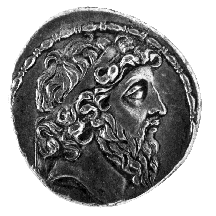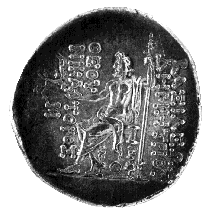



(52) Syria, Demetrios II Nikator - AR tetradrachm, second reign,
129-125 B.C., 15.79 g. (inv. 91.093).
Obverse: In bead and reel border, bearded and diademed head of Demetrios
r.
Reverse: Zeus Nikephoros enthroned l., with flying Nike in r. and scepter
in l.; beneath throne, ![]() ; monogram in l. field;
; monogram in l. field; ![]()
![]()
![]()
![]() : of King Demetrios, God, Conquerer.
: of King Demetrios, God, Conquerer.
Provenance: Hesperia Art, 1960.
Bibliography: N. Davis and C.M. Kraay, The Hellenistic Kingdoms: Portrait
Coins and History (London 1973) 217-218.
The eldest son of Demetrios I, Demetrios II came to the throne in 146 B.C.,
after killing a pretender to the throne who had killed his father. Demetrios
ruled a much reduced territory for six years, until he made war with Parthia
and was taken prisoner. He was held hostage in luxury for ten years. In
129 B.C. he returned to Syria for a second reign that lasted until his death
in 125 B.C.
The coins of Demetrios' first reign depicted a clean-shaven ruler who used
the traditional Seleukid "Apollo-on-omphalos" type on the reverse
(see no. 50), but the coins of his second reign show clear evidence of his
time in Parthia, for he wears the long hair and beard of Parthian fashion,
which he apparently adopted in captivity. The type, presumably somewhat
realistic, stands in sharp contrast to his predecessors' types, which are
more idealized in the manner of portraits of Alexander the Great.
The Zeus holding Nike on the reverse indicates that the Seleukids are reclaiming
Zeus as a patron deity. The same reverse type had been used by Antiochos
IV Epiphanes, who adopted Zeus as his patron deity, but it was usurped by
the pretender Alexander Balas, who claimed to be the son of Antiochos.
K.J.B.



All contents copyright (c) 1996.
Lawrence University
All rights reserved.